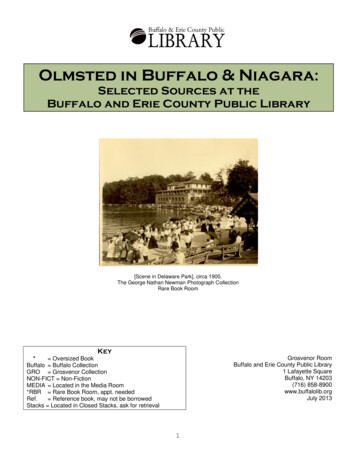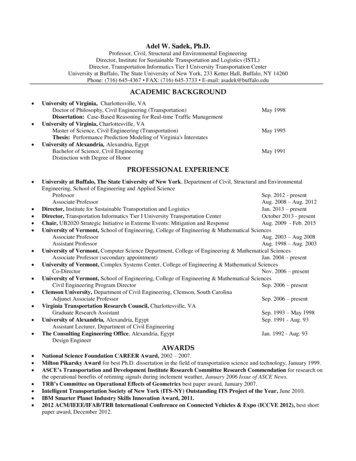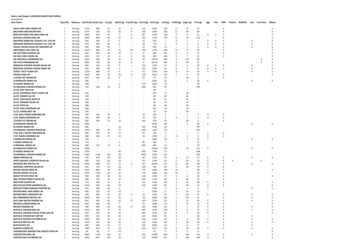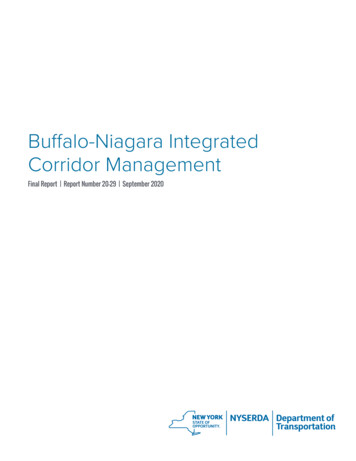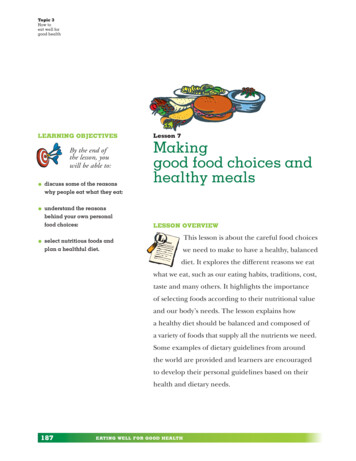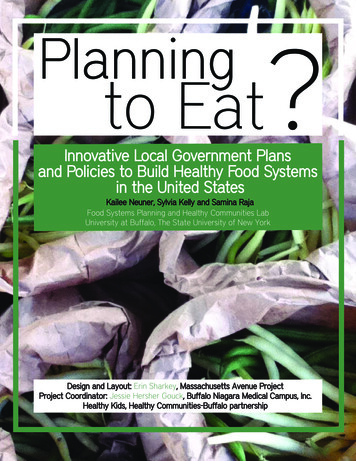
Transcription
Planning?to EatInnovative Local Government Plansand Policies to Build Healthy Food Systemsin the United StatesKailee Neuner, Sylvia Kelly and Samina RajaFood Systems Planning and Healthy Communities LabUniversity at Buffalo, The State University of New YorkDesign and Layout: Erin Sharkey, Massachusetts Avenue ProjectProject Coordinator: Jessie Hersher Gouck, Buffalo Niagara Medical Campus, Inc.Healthy Kids, Healthy Communities-Buffalo partnership
A growing number of local governmentsacross the United States are rebuilding foodsystems1 through innovative public policy.Local governments are using plans,regulatory tools, fiscal incentives, andinstitutional mechanisms to strengthenfood systems. These public policy tools arebeing developed and implemented bydifferent levels of local governments,including cities, counties, and regionalgovernments.This policy brief includes a synthesis ofrecent best practices of local governmentpolicy and planning designed to strengthencommunity food systems.September 20111 A food system refers to the network of activities, actors, resources, regulations, and institutions required toproduce, process, distribute, and dispose food.
PLANSOfficial plans adopted by local governmentsguide future public investments and shapedevelopment patterns in a community. Official planshave a profound and lasting influence on the health ofcommunities’ food systems and on residents’ ability toaccess healthful and affordable foods. Recognizing thisinfluence, many local governments seek to strengthentheir community’s food systems through official plans.Local governments incorporate food in officialplans using a variety of strategies. Some includefood as an element, or, sub-element, within theircomprehensive plans along with more traditional planelements such as land use, housing, and transportation.Food also appears as an element within sustainabilityor environmental plans. A small, but growing, numberof governments are adopting stand-alone foodsystems plans, while others are adopting plans fora particular component of the food system such asurban agriculture.2 1City-scale comprehensive plansThe ‘City of Dillingham Comprehensive PlanUpdate and Waterfront Plan’ (Alaska), adopted bythe City Council on March 3, 2011, recognizes therole of the food system in meeting its energy goal to“reduce resilience on costly imported goods; increaseproduction and reliance on local resources.” The plan’ssection on energy outlines an objective to “developinterest in the community to grow and gather foodlocally.” Strategies include education programs aboutthe benefits of growing food locally, informationabout harvesting, caring, and preparation techniques,exploring “the feasibility of developing a passivelyheated commercial greenhouse to grow food,” andsupporting and expanding an existing farmers’ market.FOOD AS AN ‘ELEMENT’ IN OFFICIAL PLANS The plan outlines a timeframe for implementing eachstrategy and identifies the entity primarily responsibleComprehensive Plansfor implementation. [2]A number of comprehensive plans adopted byThe ‘New Orleans 2030: Plan for the 21stlocal and regional governments include strategies for Century’ (Louisiana), adopted by the City Planningimproving the food system. Within comprehensive Commission in 2010, addresses food in a subsectionplans, references to the food system commonly on “Urban Agriculture, Gardening, and Open Space.”appear in sections devoted to natural and agricultural The primary goal of this section is to provide “ampleresources, environmental stewardship, or energy opportunities for all residents to participate in and(e.g. Boise, ID; Dillingham, AK; Dane County, WI; benefit from urban agriculture and communityMadison, WI; Marin County, CA; New Orleans, LA; gardening.” The plan proposes to achieve this bySouthern California Association of Governments, “support[ing] and promot[ing] urban agriculture andCA). Some comprehensive plans mention food within community gardening on public and private property.”sections devoted to health (e.g. Boston Metro Region; Suggested actions include removing zoning andHarrison County, MS). Still others interweave aspects regulatory barriers to both urban agriculture andof the food system throughout the comprehensive farmers’ markets, performing an inventory of possibleplan (e.g. Seattle, WA).gardening sites, establishing a schoolyard greeningBelow we review adopted comprehensive plans program, and providing incentives to encourage reusefrom around the country that aim to strengthen their of vacant properties for urban agriculture. [3]community’s food system. The plans reviewed in thisThe 2006 ‘City of Madison Comprehensivesection are organized by levels of government (city Plan’ (Wisconsin) addresses food in its “Natural andand county), and more recent plans appear first.Agricultural Resources” and “Economic Development”sections. The plan outlines goals, objectives, andpolicies to protect the city’s food-related resourcesincluding farmland and community gardens. Goals2See the American Planning Association’s Planning Addiscussed in the plan include “maintain[ing] existingvisory Service Report Number 563 for a detailed analysis of plansthat support urban agriculture. 1. Hodgson, K., M.C. Campbell,and M. Bailkey, Urban Agriculture: Growing Healthy, SustainablePlaces, in Planning Advisory Service. January 2011, AmericanPlanning Association. p. 145.agricultural operations in the City and encourag[ing]new, smaller farming operations such as CommunitySupported Agriculture Farms.” The plan’s objectivesinclude protection and preservation of agricultural land,3
supporting purchase of local foods, and capitalizing “on(1) developing a land bank of tax-reverted, vacant,mapping of agricultural operations located within thecity, supporting education of farmers and consumers,and expansion of community gardens to ensure onegarden per 2,000 households in the city. [4]‘Blueprint Boise’ (Idaho), a proposed updateof Boise’s comprehensive plan32, addresses food in asubsection on environmental stewardship. One goalwithin this subsection is to “promote communitybased and local food production.” Recommendedactions to reach this goal include designating publiclands for community gardens, encouraging schoolsto create community gardens on school property,adopting zoning amendments that encourage foodproduction, and allowing farmers’ markets as-a-rightin designated activity centers. In addition, as part ofa goal to “protect access to and promote use of thecity’s canal system” the plan recommends that thecity “require the use of existing water rights as newThe section on “Agricultural, Natural andCultural Resources” in the 2007 ‘Dane CountyComprehensive Plan’ (Wisconsin) expresses a strongcall “to conserve and effectively manage Danethe mutual benefit of the connections between rural and abandoned properties for agricultural uses, (2)economies as producers of food and urban economies promoting farmers markets, (3) promoting communityas processors and consumers.” The plan recommends gardens, and (4) improving local food accessibility. [7]County’s irreplaceable agricultural, natural and culturalresources, including productive agricultural areas.”The plan’s goals include protecting agricultural land,making farming economically viable, and maintainingthe rural character of the county. Objectives includeimplementing fees to convert land from agriculturaluse to non-farm use, educating farmers about costsaving measures, and encouraging compact futuregrowth. The plan recommends continued supportof the Dane County Food Council, revision of thecounty’s zoning and land division ordinances “toestablish design guidelines that minimize conversionof agricultural land, and support farm operations andagriculture-related businesses,” and development of adevelopment occurs, particularly to support urban viable and affordable option of health insurance foragriculture and community gardens.” [5]rural farmers. [8]References to the food system are interwoventhroughout the 2005 update of the ‘City of SeattleComprehensive Plan’ (Washington), which is intendedto guide the city’s growth and development to 2024.The plan makes several references to the provisionof community gardens as both a goal and a strategyto reach other overarching goals. The plan identifiesa target standard of one community garden per2,500 households in each designated “village” areathroughout the city. [6]County-scale comprehensive plansThe ‘2030 Harrison County ComprehensivePlan’ (Mississippi), adopted by the Harrison CountyBoard of Supervisors and the citizens of HarrisonCounty in 2008, addresses the food system in itssection on healthy communities. The section aimsto ensure that residents “live in healthy communitiesThe award winning ‘Marin Countywide Plan’(California), adopted by the County Board of Supervisorsin 2007, includes a subsection on “Agriculture andFood” that includes three food-related goals: (1)“preservation of agricultural lands and resources,” (2)“improved agricultural viability,” and (3) “communityfood security.” The plan recommends that the county* Limit permitted non-agricultural developmentwithin the Agricultural Production Zone to a “buildingenvelope covering no more than 5% of the property.”* Subject any proposed residential development above4,000 square feet [located in agricultural areas] todesign review.* Limit single family residences to less than or equal to7,000 square feet in agricultural areas.that have opportunities for active living, recreation,affordable healthy foods, and services for vulnerablepopulations.” One specific goal of the plan is to“increase access to healthy food options in HarrisonCounty.” The county proposes to achieve this goal by3The plan was recommended for approval toCity Council on May 10, 2010. It is currently beingreviewed by Council.4
The plan includes specific indicators, benchmarks, and targets to measure and evaluate progress towards goals(see example below). [9]Marin County Comprehensive Plan – Indicators and targets for strengthening the food systemIndicatorsAcres preserved with agricultural easements.Benchmarks28,377 acres preservedin 2000Acres of land farmed organically357 acres in 2000Annual sales of identified Marin farmers’ 9,860,000 in 2005markets: Civic Center, Downtown SanRafael, Novato, and FairfaxTargetsIncrease by 25,000 acres by 2010and by 12,500 additional acres by2015Increase by 1,500% by 2010 and1,700% by 2015Increase annual sales 10% by 2010and 15% by 2015* “Amend the Development Code to require space plan also recommends the use of “school-basedfor on-site community gardens in [all] new residential programs to help children establish healthy lifestyles”developments of 10 units or greater.”including improving school nutrition, creating “EdibleSchoolyards,” and expanding farm-to-school programs.Finally, the plan suggests reconnecting public healthRegional-scale comprehensive plansAdopted in 2008 by the Metropolitan Area and planning issues by establishing “coordinatingmechanisms between health and planning boards and“to better the lives of the people who live and work agencies.” [12]in Metropolitan Boston (Massachusetts) between nowOn the West Coast of the country, the ‘Regionaland 2030” [10]. References to the food system existPlanning Council (MAPC), the ‘MetroFuture Plan’ aimsthroughout the plan but are explicit in a section on“Community Vitality.” The plan envisions a healthycommunity and a healthy food system and outlinesthe following goals and objectives to achieve thisvision:Comprehensive Plan’ accepted by the RegionalCouncil of the Southern California Association ofGovernments (SCAG) in 2008 addresses the foodsystem within a section on “Agricultural Lands.” Themain goal outlined in this section is to:Preserve the productivity and viability of theregion’s agricultural lands while supporting asustainable economy and region by maintaining aviable level of agriculture to support economic andfood supply needs for the region while supportingsustainable energy, air quality and transportationpolicies [and by] promot[ing] and support[ing] astrong locally-grown food system by encouragingcommunity farming and developing cooperativefarming initiates that use sustainable farmingpractices.* All neighborhoods will have access to safeand well-maintained community gardens* Residents in all communities and of all incomes willhave access to affordable, healthy food* The region’s agricultural economy will growthrough a focus on sustainable farming and bybringing more locally produced food to the market [11]The plan recommends that the legislatureestablish a Massachusetts Food Policy Council,the Massachusetts Office of Small Business andEntrepreneurship assist healthy food stores withfinancing, and theMassachusettsAvenue of BusinessDevelopmenttodevelop an “urbanThe plans calls for the enrollment of 6,500 acresof prime farmland in the region’s new conservationprogram within the first four years and no net loss offarm acreage enrolled in the program through 2035.[13supermarketinitiative.”The5
Environment, Sustainability,and Climate Change Plans‘The Baltimore Sustainability Plan’ (Maryland),approved by the Baltimore City Council in 2009, aimsIn recent years, local governments have to “establish Baltimore as a leader in sustainable, localbegun to recognize that any efforts to improve the food systems.” Strategies to rebuild food systemsenvironment and tackle climate change must also appear in various sections of the plan; key strategiesaddress the food system. A growing number of are noted below (chapters shown in parenthesis):environmental, sustainability, and climate changeplans include entire sections devoted to building 1. increas[ing] the percentage of land under cultivationsustainable food systems as a strategy for improving for agricultural purposes (Greening)the environment and addressing climate change (e.g.Portland and Multnomah County, OR; Baltimore, MD; 2. improv[ing] the quantity and quality of food availableat food outlets (Greening)Philadelphia, PA; Santa Fe, NM; Toronto, ON).The ‘Climate Action Plan 2009,’ adoptedby the city of Portland and Multnomah County(Oregon), provides a guide to future development inresponse to climate change, and includes a chapteron “Food and Agriculture.” The chapter discusses theimpact of the food system on carbon emissions, andincludes two food-related objectives to reduce theimpact on climate change. The objectives are to: 1)“reduce the consumption of carbon-intensive foods”and 2) “significantly increase the consumption oflocal food.” The plan recommends concrete actionsto achieve these objectives before 2012, includingpartnering with schools to promote healthy low-carbondiets and the provision of incentives and removal ofregulatory barriers to encourage local food production.Measureable actions include promoting fruit andnut trees as part of a ‘Grey-to-Green’ tree-plantinginitiative to plant 33,000 trees in private yards as wellas “develop[ing] or facilitat[ing] 1,000 new communitygarden plots.” [14]3. increase[ing] demand for locally-produced, healthyfoods by schools, institutions, supermarkets, andcitizens (Greening)4. develop[ing] an urban agriculture plan (Greening)5. implement[ing] Baltimore Food Policy Task Forcerecommendations related to sustainability and food(Greening)6. compil[ing] local and regional data on variouscomponents of the food system (Greening)7. compost[ing] residential yard and food wasteand commercial food waste to the greatest extent(Resource Conservation). [15]Released in 2009 by Philadelphia Mayor’sOffice of Sustainability, ’Greenworks Philadelphia’(Pennsylvania), is a sustainability plan to makePhiladelphia “the greenest city in America.” The planconsiders sustainability through five lenses: energy,environment, equity, economy, and engagement.Two of these – environment and equity - addressthe food system. To reach its environmental goal of“[diverting] 70 percent solid waste from landfills,” theplan’s environmental section encourages compostingto reduce food waste. The equity section prioritizesfood access by establishing a target to “bring localfood within 10 minutes of 75 percent of” city residents.Recommended actions to reach this goal includeincreasing access to fresh foods by creating 59 foodproducing gardens, 12 farms, and 15 farmers’ markets,creating an inventory of community gardens, urbanfarms, and farm stands, providing technical assistanceto farmers/gardeners, leveraging vacant city-ownedland for gardening purposes, fostering commercial6
farming, encouraging distribution of healthy foods inneighborhood stores, and supporting food cooperativeexpansions. The plan also recommends ortunities such as “creat[ing] an agriculturalFOOD SYSTEMPLANSThe ‘Sustainable Santa Fe Plan’ (New Mexico),adopted by the City of Santa Fe in 2008 to reducegreenhouse gas emissions, includes a chapterdedicated to the food system. Although food-relatedinitiatives to decrease “food miles” already exist inSanta Fe, the plan proposes three additional strategies.food system plans. These food system plans have beendeveloped at varying scales, including neighborhoods(e.g. Buffalo, NY), municipalities (e.g. New York, NY;Oakland, CA; Toronto, ON), counties (e.g. Dane County,WI; Multnomah, OR), and regions (e.g. Delaware ValleyRegion, PA; Waterloo, ON). They describe communities’goals for their food systems, assess the conditionsof food systems, and make recommendations forimproving them.A few communities have also developed plansfor a specific component of the food system (i.e.production, processing, distribution, etc.). Existing plansfor a particular component of the food system tend tofocus on food production (e.g. urban agriculture plans)rather than processing, distribution, or disposal.workforce strategy to grow green jobs” andA small, but growing, number of local“support[ing] green kitchen development.” [16]governments have created stand-alone, comprehensive,1. To set a target for the percentage of consumed foodto be grown locally; e.g., the plan proposes that the cityestablish a target such as 30% of the food consumedbe from a 300-mile foodshed by 2018.2. To design and implement a City Harvest programwhich provides multiple opportunities for growing,processing, storing, and selling food.3. To “develop a foodshed (within 300 miles range)program in collaboration with regional partners.” Thiswould include hiring a coordinator, expanding existingprograms, preserving productive land, exploringfood-related policies, and reducing transportation bycoordinating a cooperative back-hauling43 program.[17]The ‘Change is in the Air: Climate Change, CleanAir and Sustainable Energy Action Plan,’ released bythe city of Toronto’s Environment Office and adoptedby Toronto City Council in 2007 (Ontario), directsseveral recommendations to the food system. [18]The plan recommends that the City establish a LiveGreen Toronto Program “to support residents’ groups,Business Improvement Areas and other neighbourhoodagencies and community groups to green their ownneighborhoods through a range of programs” such asplanting food gardens at parks and homes. The planalso recommends new institutional mechanisms suchas the creation of “an Enviro-Food Working Group toComprehensive Food System PlansNeighborhood-Scale food system planIn 2003 the Massachusetts Avenue Project, incollaboration with a graduate planning studio from theUniversity at Buffalo (State University of New York),released ‘Food for Growth: A Community Food SystemPlan for Buffalo’s West Side.’ Focused on a specificneighborhood on the west side of Buffalo, New York,this plan assesses the neighborhood’s food securityand the food system, and provides recommendationsfor improvement. Recommendations within fourstrategic areas include: (1) enhancing local foodproduction through effective land use planning and byconnecting consumers with Western New York farmers,(2) promoting food-based economic development,(3) improving transportation access to food, and (4)facilitating youth development through food-basedprojects. The plan has been since implemented by theMassachusetts Avenue Project. [20]develop and implement actions to promote local foodproduction, review City procurement policies, increasecommunity gardens, and identify ways to remove City-wide Food System Plansbarriers to the expansion of local markets that sellIn 2010 the New York City Council releasedlocally produced food.” [19]‘Food Works: A Vision to Improve NYC’s Food System,’ a4Most trucks that deliver food products returnto the distribution centers empty. This program wouldmaximize the use of the trucks, ensuring they wereloaded in both directions.comprehensive food system plan which outlines goalsand strategies for production, processing, distribution,consumption, and post-consumption of food. Foodproduction goals include preservation of and increase7
in urban and regional food production. Strategies to quality of institutional meals by “expand[ing] themeet these goals include “strengthen[ing] regional capacity of city agencies to cook whole foods forfood supply channels, leverag[ing] the city’s economic nutritious meals;” and, to “increase [the] quantity andpower to support regional producers,” using existing quality of opportunities for food, nutrition, and cookingspace for urban food production more effectively, knowledge.” [21]and “restor[ing] food and horticultural knowledge.”Post consumption goals included in the planFood processing goals include generating growth are to “decrease waste throughout the food systemand employment in the food manufacturing sector and increase resource recapture in the food system” byby making affordable space and technical assistance “improv[ing] the net environmental impact associatedavailable to food manufacturers; to “increase regional with food procured by city agencies and institutions,products processed in and for New York City” by increas[ing] residential, commercial, and governmentalfacilitating urban-rural linkages; and, to “reduce the composting, and increas[ing] recycling of waste relatedenvironmental impact associated with food processing to food processing and packaging.” [21]in New York City” by helping businesses reduce energyconsumption. [21]Also in 2010, on the West Coast of the country,Food distribution goals include “improve[ing] the Oakland Food Policy Council (California), anfood distribution in New York City through infrastructure advisory group for the city, released ‘Transforming theOakland Food System: A Plan for Action.’ Building onenhancements, technological advances, alternativea previous food system assessment, the food policycouncil recommends that the city: (1) protect andexpand urban agriculture, (2) encourage accessibleand affordable farmers’ markets, (3) promote useof food assistance programs at farmers’ markets,(4) develop environmentally preferable purchasingprotocols, (5) expand composting and food scraprecycling, (6) develop a fresh food financing initiative,(7) encourage healthy mobile vending, (8) establishsynthetic pesticide and GMO-production free zones,(9) scale up local purchasing, and (10) strengthencommunity-government links. [22]transportation, and integrated planning.” Strategiesto reach this goal include “expand[ing] on the currentvision for the Hunts Point Food Distribution Center tomaximize its potential and diversify[ing] and improv[ing]food transport.” [21]Food consumption goals of the plan are to“create a healthier food environment” by “expand[ing]fresh food retail in underserved areas of the city,”supporting “food outlets that provide fresh and healthyfoods” better, and “discourag[ing] unhealthy foodconsumption.” The plan also aims to “strengthen thesafety net of hunger and nutrition programs” through“improv[ing] federal food programs and remov[ing]local barriers to enrollment,” improve nutritionalThe City of Toronto (Ontario), which hasled the forefront of the food systems work in NorthAmerica, is currently in the throes of preparing a foodsystems plan. The city’s Public Health Departmentis preparing a comprehensive food system plan aspart of the Toronto Food Strategy project to createa health-focused food system. As a precursor to thisplan, in 2010 the Public Health Department released‘Cultivating Food Connections’ which proposes a visionfor a healthy food system. The document describes“numerous opportunities for Toronto to championfood system renewal” and “is the product of broadconsultation with individuals and groups across Citygovernment and the community.” The findings in thisdocument will be used to inform the comprehensivefood system plan which is scheduled for presentationto the Toronto Board of Health in May 2011. [23]8
County-wide food system planThe Multnomah County Office of Sustainability(Oregon) released the ’Multnomah Food Action Plan:Grow and Thrive 2025’ in December 2010. Theplan aims to “achieve a local, healthy, equitable, andregionally prosperous food system” through “education,committee of the Dane County Board, released ’Recipefor Success,’ a plan to improve the county’s foodsystem. The plan makes calls for an effort to “buy fresh/buy local” through institutional purchasing policies51,“establish[ing] a countywide network of farmers’call to action which includes 16 community-identifiedgoals, and 60 organization-based actions related tolocal food, healthy eating, social equity, and economicvitality. Selected indicators in the plan includeincreasing the number of full service grocery storesby 20%, increasing participation in the Supplementaland Nutrition Assistance Program (SNAP) by fivepercentage points, reducing number of low-incomehouseholds living farther than one mile from a grocerystore by 20 percent, reducing fast food expendituresper capita by 10%, and reducing obesity rates amonglow-income preschool by three percentage points – allover a period of 15 years. [24]In July 2005 the Dane County Local FoodPolicy Advisory Subcommittee (Wisconsin), appointedby the Environment, Agriculture and Natural Resourcesstakeholder community, and the creation of a businessplan for the development of a Public Market as well asa Central Agricultural and Food Facility. The plan alsocalls for the “promot[ion] of farmland preservation andentrepreneurial agriculture” by adhering to the county’scomprehensive plan, promoting “small acreage farmingmarkets, support[ing] farm-to-school programs, andcommunity empowerment, planning integration, policy identify[ing] areas of need.” The plan recommends theprioritization, and investment.” The plan includes a completion of a needs assessment, organization of azones, support[ing] entrepreneurial agriculture, andsupport[ing] local farmland preservation initiatives.”The plan recommends improving access to local foods“to improve health and nutrition,” collaborating withanti-hunger advocates to establish a “Market Basket”program, supporting and enhancing an existing DaneCounty Extension Nutrition Education Program,devoting county-owned land for community gardens,encouraging direct marketing, CSA farms, farm stands,and U-Pick operations, and networking with existingDane County Health and Nutrition projects. The planalso recommends the establishment of a Dane CountyFood Council, which has since been established. [25]Regional-scale food system planRegional food system plans provide a promisingopportunity to strengthen urban and rural linkageswithin a food system. Based on an extensive foodsystem study [26], ’Eating Here: Greater Philadelphia’sFood System Plan,’ published in February 2011 by theDelaware Valley Regional Planning Commission, aimsto increase “the security and economic, social, andenvironmental benefits of the regional food systemthat feeds Greater Philadelphia.” The plan’s ultimategoal is to create “a food system in which agricultureis a valued and economically viable occupation,natural resources are preserved and regenerated,healthy food is accessible and affordable, and diversityexists throughout the region.” The plan makes 52recommendations to achieve this goal (althoughimplementing actors are purposely not identified). [27]5Specific recommendation - The County shouldset a goal that 10% of its food-related purchases shouldbe made locally within three years9
Key recommendations include:1. Addressing the retirement needs of farmers,transitioning preserved land into food production, andcreating investment vehicles for long-term agriculturalproduction on preserved land2. Development of technical assistance programs ormarket-based solutions that enable farmers to protectnatural resources3. Creation and expansion of programs to reducebarriers to entry for new farmers and food entrepreneurs4. Integration of Farm-to-School programs into arobust and comprehensive education program5. Continual convening of the Greater PhiladelphiaFood System Stakeholder Committee [27]In April 2007 the Region of Waterloo (Ontario)Public Health Department released ‘A HealthyCommunity Food System Plan.’ Building on a studycompleted in 2005, this plan provides objectives,strategies, and actions to improve the region ofWaterloo’s food system. The seven main objectives areto: (1) “ensure all residents can afford to buy the foodthey need to sustain health,” (2) “preserve and protectWaterloo Region’s agricultural lands,” (3) “strengthenfood-related knowledge and skills among consumers,”(4) “increase the availability of healthy food so thatthe healthy choices are easier to make,” (5) “increasethe viability of farms that sell food to local marketsin order to preserve rural communities and culture,”(6) “strengthen the local food economy,” and (7)“forge a dynamic partnership to implement the plan.”Strategies include “increas[ing] urban agriculture,expand[ing] local farmers’ markets, encourag[ing] localfood processing.”to focus on food pr
section on healthy communities. The section aims to ensure that residents "live in healthy communities that have opportunities for active living, recreation, affordable healthy foods, and services for vulnerable populations." One specifi c goal of the plan is to "increase access to healthy food options in Harrison County."


